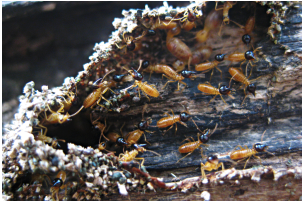When it comes to pests these ones are the most destructive in the U.S., causing damage well into the billions of dollars annually. Eastern Subterranean Termites are known for consuming wood, but will also feed on and damage almost anything that contains cellulose such as pages of books and other papers. The workers are not able to digest cellulose on their own and depend on microorganisms that reside in the workers termite’s stomach. To breakdown the cellulose into nutrients that workers feed to the other castes within the colony. Eastern Subterranean Termites establish their colonies underground, and the workers then use networks of tunnels located both above and below ground to search for cellulose.
An interesting fact is that termite workers are constantly foraging for food and when a food source is located the workers communicate the food source location by depositing complex odors called pheromones along trails. Above ground foraging also takes place, and the typical termite mud tube must be constructed when workers forage above ground. The mud tube’s purpose is to protect the workers as they explore for new sources of food or travel back and forth with the food they bring back to nourish the colony members.
There are numerous termite species native to the United States. Eastern subterranean termites (Reticulitermes flavipes) are a subterranean species found in the Wichita are as well as into the South and on the East Coast. These insects can have a large economic impact on homeowners, due to their dense distribution.
Eastern subterranean termites are social insects, using their collective might to accomplish large-scale tasks. Established infestations can range from 5,000 to millions of insects and are divided into three castes in any given colony. Workers are responsible for food and maintenance, while soldiers use their oversized mandibles to protect their colonies. Reproductive termites, known as kings and queens, ensure that colonies grow in population.
Before purchasing a home a termite inspection is often required by lenders. After home purchase, it’s a good idea to continue annual inspections and precautionary measures for termite control. Signs of an infestation include: Finding shed swarmer wings or winged swarmer around windows, patio doors or other sources of light. The presence of mud tubes. Wood material in the home that appears to be soft, easily penetrated, rippled, peeling or bubbled. If you see any of these signs, you should contact All Star Pest Control right away.
Infestation is not something to mess around with especially with Termites. They can cause a lot of damage on a home costing the homeowner thousands of dollars. If you notice any of these signs do not wait call and get the problem solved right away. Are trained professional can stop the infestation and help make sure an infestation won’t happen again.

